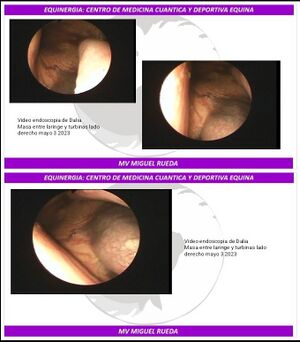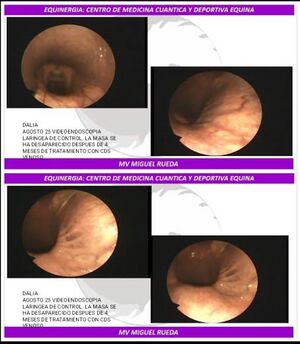Tumor between larynx and turbines in horse: Difference between revisions
Created page with "left|thumb|'''Before''' thumb|'''After''' The remarkable case of Dr. Vet Miguel Rea showcases clinical evidence through a series of images that illustrate the impressive remission of a tumor located between the larynx and the turbinates in a horse. This particular mare underwent an endoscopy procedure, which was followed by an extensive CDS treatment regimen lasting four months. T..." |
No edit summary |
||
| Line 1: | Line 1: | ||
[[File:Photo 448@03-09-2023 20-02-02.jpg|left|thumb|'''Before''']] | [[File:Photo 448@03-09-2023 20-02-02.jpg|left|thumb|'''Before''']] | ||
[[File:Photo 447@03-09-2023 20-02-02 thumb.jpg|thumb|'''After''']] | [[File:Photo 447@03-09-2023 20-02-02 thumb.jpg|thumb|'''After''']] | ||
'''Case Report: Tumor Remission in Equine Patient Following CDS Treatment''' | |||
'''Patient Profile:''' | |||
* Species: Equine | |||
* Gender: Female (Mare) | |||
* Location of Tumor: Between the larynx and turbinates | |||
'''Attending Veterinarian:''' | |||
* Dr. Vet Miguel Rea | |||
'''Clinical Background:''' | |||
The mare presented with a tumor located in the upper respiratory tract, specifically between the larynx and turbinates. An endoscopic examination was performed to assess the extent and nature of the tumor. | |||
'''Intervention:''' | |||
Following the diagnostic endoscopy, a comprehensive treatment protocol utilizing Cellular-Derived Substances (CDS) was initiated. The regimen spanned four months and included both oral and intravenous administration of whole animal therapy. | |||
'''Results:''' | |||
Post-treatment evaluations revealed a significant reduction in tumor size, with imaging evidence indicating remarkable remission. The clinical signs observed prior to treatment, including respiratory distress and dysphagia, improved substantially. | |||
'''Discussion:''' | |||
This case underscores the therapeutic potential of CDS in veterinary medicine, particularly for challenging cases involving neoplasia in equine patients. The successful outcome not only demonstrates the efficacy of the treatment protocol but also highlights advancements in innovative veterinary practices aimed at improving patient care. | |||
'''Conclusion:''' | |||
The extraordinary recovery of this mare emphasizes the importance of continued research and application of novel therapeutic strategies in veterinary oncology. Further studies are warranted to explore the long-term effects and mechanisms of action associated with CDS treatment in equine patients. | |||
Latest revision as of 15:20, 25 August 2024


Case Report: Tumor Remission in Equine Patient Following CDS Treatment
Patient Profile:
- Species: Equine
- Gender: Female (Mare)
- Location of Tumor: Between the larynx and turbinates
Attending Veterinarian:
- Dr. Vet Miguel Rea
Clinical Background:
The mare presented with a tumor located in the upper respiratory tract, specifically between the larynx and turbinates. An endoscopic examination was performed to assess the extent and nature of the tumor.
Intervention:
Following the diagnostic endoscopy, a comprehensive treatment protocol utilizing Cellular-Derived Substances (CDS) was initiated. The regimen spanned four months and included both oral and intravenous administration of whole animal therapy.
Results:
Post-treatment evaluations revealed a significant reduction in tumor size, with imaging evidence indicating remarkable remission. The clinical signs observed prior to treatment, including respiratory distress and dysphagia, improved substantially.
Discussion:
This case underscores the therapeutic potential of CDS in veterinary medicine, particularly for challenging cases involving neoplasia in equine patients. The successful outcome not only demonstrates the efficacy of the treatment protocol but also highlights advancements in innovative veterinary practices aimed at improving patient care.
Conclusion:
The extraordinary recovery of this mare emphasizes the importance of continued research and application of novel therapeutic strategies in veterinary oncology. Further studies are warranted to explore the long-term effects and mechanisms of action associated with CDS treatment in equine patients.
